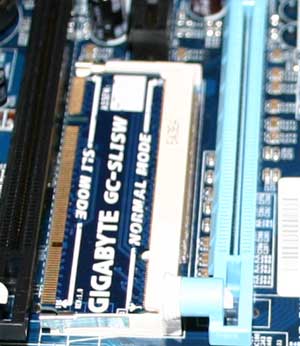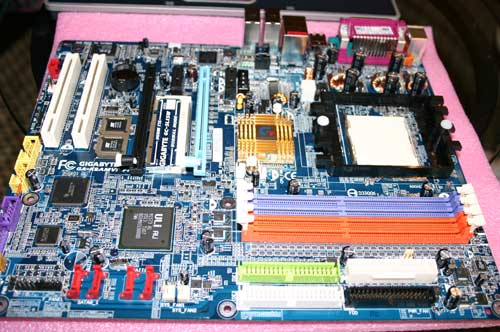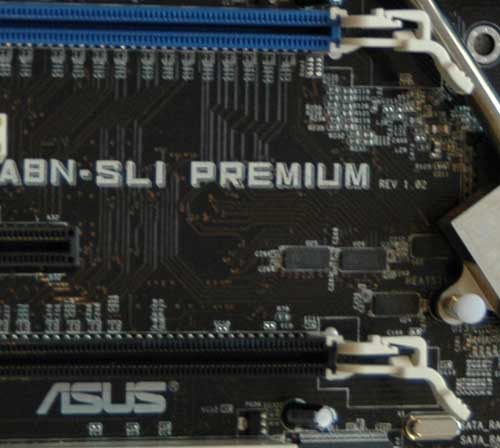ATI's Multi-GPU Solution: CrossFire
by Anand Lal Shimpi & Derek Wilson on May 30, 2005 9:00 PM EST- Posted in
- GPUs
What Happened to the Selector Card?
One of ATI's most interesting claims with their CrossFire solution is that you no longer need the selector card that is seen on nForce4 SLI motherboards. How is it that ATI is able to get around this requirement? Contrary to popular belief, it's not magic.By default, the nForce4 SLI chipset sends all 16 PCI Express lanes from the North Bridge to the first PCI Express x16 slot on a nForce4 SLI motherboard.
Flipping the selector card the other way divides the PCI Express lanes and sends the first 8 lanes to the first slot and the remaining 8 lanes to the second slot.
ATI's MVP chipset works slightly differently; by default, the North Bridge sends 8 PCI Express lanes to each of the two PCI Express slots. If you have two cards installed, then this is the desired configuration. However, if you only have one card installed, in order to get a full PCI Express x16 slot, one of the following methods must be implemented by the motherboard manufacturer:
Option 1 - Terminator Card
The first option is a terminator card that is installed into the second PCI Express x16 slot. This card simply reroutes the 8 PCI Express lanes going into the slot back to the first PCI Express slot, giving it all 16 PCI Express lanes.

Obviously, the downside to this approach is that you have to use a terminator card; we haven't heard of many manufacturers doing this.
Option 2 - SLI Selector Card
The second option is to implement the same selector card that is used in nForce4 SLI motherboards. If you want a single x16 slot, flip the card one way. If you want two x8 slots, just change its orientation and you are good to go.

The obvious downside here is that the user has to play with the selector card, something that ATI wants to avoid. Despite ATI's desire to avoid this card, some manufacturers are implementing it:

Option 3 - Selector ICs
The third (and most expensive) option is for the motherboard manufacturer to place a series of selector ICs (Integrated Circuits) on the motherboard itself, which will allow for the user to switch between one x16 slot or two x8 slots from within the BIOS. This is the most desired implementation from the end user's standpoint, but it is the most expensive option.
Either 4 or 5 chips have to be placed on the motherboard in order to allow for this software-selection of PCI Express configuration. Each chip costs the motherboard manufacturer approximately $1, which isn't really a problem for high end motherboards.

Note that there is also no reason why the same technology can't be implemented on nForce4 SLI motherboards; in fact, ASUS has already implemented it on their latest nForce4 SLI solution:











57 Comments
View All Comments
yacoub - Tuesday, May 31, 2005 - link
Is it just me or do several things about this scream "bottleneck" and "latency"? The 2PCI-E x8 slots instead of x16 slots. The extra Compositing Engine chip. The ability to pair different cards such that it will drop clock speeds and/or pipelines to sync them up. The lack of direct chip-to-chip interconnect.I'm curious to know just how much performance gain is realized if you pair, say, an X800XL and an X850-something, over just the X850-something. And also how much bottleneck and latency there is in this implementation over the NVidia offering of SLI.
The only upside I can see is cost/upgrade since a user can own an X800-based card (assuming they have a Crossfire compatible motherboard) and go out and buy an X850-based card later and use BOTH cards together (assuming they are both Crossfire-capable cards). Then again with those assumptions I'm not sure it's truly any more cost-effective. =\
LoneWolf15 - Tuesday, May 31, 2005 - link
As usual, the fanboys of both sides come to the show to spout their comments.For everyone saying "Man, you have to buy a Crossfire that matches your card, and throw it away when you upgrade"...umm, don't you have to buy two of the exact same matching card for running nVidia SLI, and if you wish to upgrade, you have to sell both? Doesn't sound that different to me. One thing I think a lot of current ATI owners will be happy about is that they won't have to get rid of a card they already own and buy two of a new one; they can just buy a single Crossfire card (and of course a mainboard).
On the other hand, to those thinking ATI has now "0wned" nVidia, it is WAY too early to tell. The solution looks promising, but if you have to sacrifice mainboard performance (i.e., SATA hard disks, memory bandwidth, etc.) it may be a hard sell. Benchmarks in Doom 3 are also not the end-all be-all. We'll have to wait for a more comprehensive performance review, including DirectX benches, and performance/quality with older games using this new AA method, as well as game compatibility reports. We'll also need to know what TRUE pricing is (we've seen claimed pricing vary quite a bit from what it has turned out to be at product release in the past two years).
Do I hope it will beat nVidia's solution? You bet. I like ATI, but even more I like competition that drives the industry. Do we proclaim ATI the winner/loser on this one? Heck no, it isn't even a purchaseable product yet.
ElMoIsEviL - Tuesday, May 31, 2005 - link
23 - They ran Doom3.It's not an ATi game at all as we all know. And it still does REALLY well. And it's not in release stages yet.
;)
ElMoIsEviL - Tuesday, May 31, 2005 - link
hehehehe.. it's better then SLi... heheheheFigures, all the NV on here prolly aren't too happy today.
I can't wait to test out the new AA modes.. :)
vertigo1 - Tuesday, May 31, 2005 - link
This is insane, who on earth will buy this?!JarredWalton - Tuesday, May 31, 2005 - link
30 - Yes. The PCIe bus likely provides slower performance, as it is used for lots of other things (like communication between the CPU, RAM, and GPUs). I believe NVIDIA SLI works without the dongle but at slower speeds - at least, I heard that somewhere, but I haven't ever had an SLI board so I can't say for sure. Anyway, since DVI is a digital signle, using DVI in/out seems about as good as the SLI bridge - at least in theory. Now we just need to wait and see how theories pan out. :)Jalf - Tuesday, May 31, 2005 - link
I was under the impression they were going to use the PCI-E bus for transferring data between the cards. Is the external dongle going to handle that instead?Murst - Tuesday, May 31, 2005 - link
I really don't see how the xfire is better than sli based on hardware compatibility. Sure, you don't need the exact same cards, but you will likely buy only one x850 type card per x850 xfire. It would be extremely unlikely that someone upgrades from x850 xt pro -> x850 xt pe.Basically, in the end, you will buy a specific xfire tailored to your gfx card, and throw it away with the next generation of cards.
gxsaurav - Tuesday, May 31, 2005 - link
Great this just means more heat, man, even a single 6800 nU playes everygame fine, while running coolViRGE - Tuesday, May 31, 2005 - link
#21, yes it is. This is what hurts ATI the most, Nvidia already had 4 release cycles of experience with motherboards(2 of those being highly popular, highly recommended boards) before attempting SLI. ATI has a previous launch for a board almost universally ignored. I would not use an ATI board at this time, so I would also not consider CrossFire. ATI needs to get CrossFire working on Nvidia's boards to have a fighting chance this round.